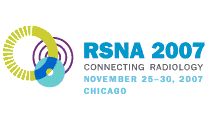
Abstract Archives of the RSNA, 2007
SSA15-08
Development and Evaluation of a Novel Lung Nodule Segmentation Method in Multislice CT by Use of a Spiral Scanning Technique
Scientific Papers
Presented on November 25, 2007
Presented as part of SSA15: Physics (Thoracic CAD )
Jiahui Wang PhD, Presenter: Nothing to Disclose
Roger Engelmann MS, Abstract Co-Author: Nothing to Disclose
Qiang Li PhD, Abstract Co-Author: Patent agreement, General Electric Company
Patent agreement, Toshiba Corporation
Patent agreement, R2 Technology, Inc
Patent agreement, Deus Technologies, LLC
Patent agreement, Riverain Medical
Patent agreement, MEDIAN Technologies
Patent agreement, Mitsubishi Corporation
Consultant, Riverain Medical
To develop a simplified and accurate nodule segmentation method in three-dimensional (3D) computed tomography (CT) by use of a new spiral scanning technique, and to evaluate its performance level by use of a standard CT database provided by the Lung Imaging Database Consortium (LIDC), which makes it possible to facilitate comparisons with other segmentation methods.
Our database included two LIDC datasets that contained 23 and 86 CT scans, respectively, with 23 and 73 nodules that were 3mm or larger in diameter (mean: 9mm). Our segmentation method was trained on the first dataset and was evaluated on the second. We first determined a volume of interest (VOI) at the location of a nodule. We then transformed the three-dimensional (3D) VOI into a 2D image by use of a key spiral-scanning technique, in which a radial line originating from the center of the VOI spirally scanned the VOI from the north pole to the south pole. The voxels scanned by the radial line provided a transformed 2D image. Because the surface of a nodule in 3D image became a curve in the transformed 2D image, the spiral scanning technique considerably simplified our segmentation method and enabled us to obtain reliable results. We employed a dynamic programming technique to delineate the “optimal” curve in the 2D image, which was transformed back into the 3D image to provide the surface and interior of the nodule. An overlap between nodule regions provided by the computer and radiologists was employed as a performance metric.
The mean overlap metrics were 65% (range: 50-90%) and 65% (36-92%) for the nodules in the first (training) and second (testing) dataset, respectively. For the second dataset, the mean overlap values were 63% (36-90%) and 70% (51-92%) for 52 small (<10mm) and 21 non-small (≥10mm) nodules, respectively. As expected, the accuracy was higher for larger nodules than for small nodules.
Our segmentation method provided relatively high performance for lung nodules and would be useful for lung cancer quantification, detection and diagnosis.
Accurate segmentation of lung nodules in CT would be useful for lung nodule quantification (doubling time), detection and diagnosis.
Wang, J,
Engelmann, R,
Li, Q,
Development and Evaluation of a Novel Lung Nodule Segmentation Method in Multislice CT by Use of a Spiral Scanning Technique. Radiological Society of North America 2007 Scientific Assembly and Annual Meeting, November 25 - November 30, 2007 ,Chicago IL.
http://archive.rsna.org/2007/5011135.html

